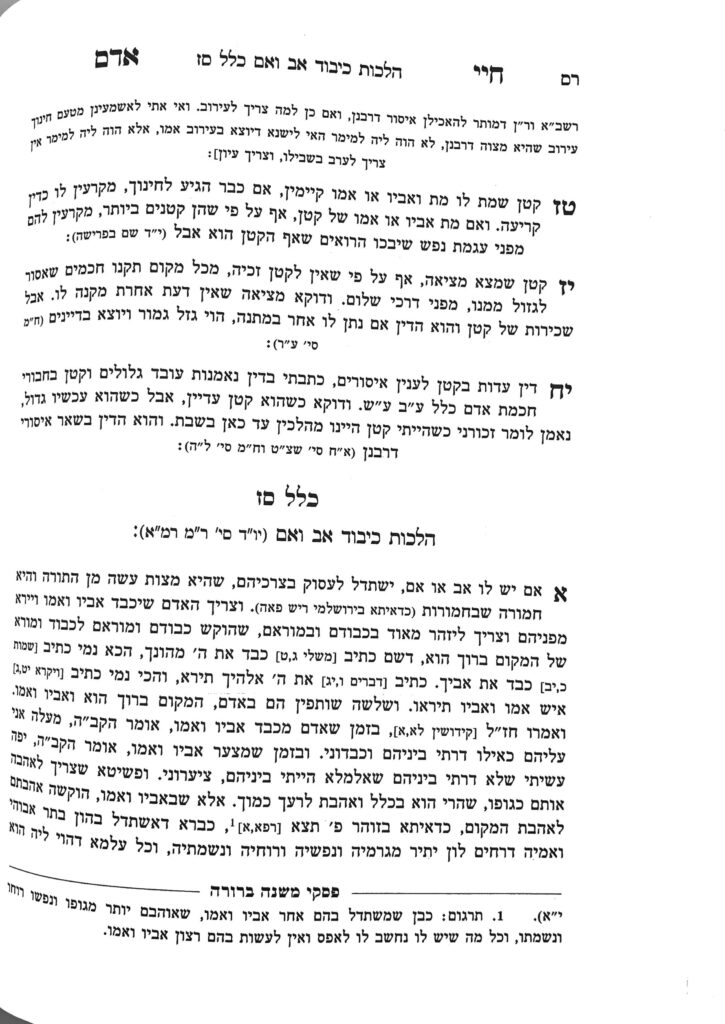We are beginning Klal 67, which discusses the halachos of kibud av v’eim. The Chayei Adam begins with a specific demonstration of kibud av v’eim, and then discusses a general hashkafic idea.
The Chayei Adam writes that a person whose parent(s) are alive should strive to take care of their needs, as we are commanded in the Torah. The Yerushalmi writes that kibud av v’eim is one of the most important mitzvos.
The Torah tells us to demonstrate both kavod and yirah to parents. The Gemara compiles a list of specific actions which fulfill both of these pesukim. However, the Chayei Adam clarifies that the lists of the Gemara are not exhaustive, but rather the Torah is describing an attitude of how to approach the concept of kibud av v’eim, and Chazal give us certain examples to help us understand the Torah’s attitude. It is interesting that the Shulchan Aruch also simply quotes the lists of the Gemara, also giving this impression. However, like the Chayei Adam writes, the Shulchan Aruch’s list is not exhaustive.
The Chayei Adam writes that one must be extremely careful to give the kavod and yirah necessary to a parent, as the Torah equates the kavod given to Hakadosh Baruch Hu and the kavod given to parents. He quotes the Gemara (Bava Metziah and Kiddushin) which explains that we see they are equated because the Torah uses parallel language both by the kavod necessary to give Hashem, and the kavod necessary to give parents. Similarly, the Torah uses parallel language regarding the yirah necessary to feel towards Hashem and the yirah necessary to feel towards a parent. The Gemara concludes that the Torah uses parallel language to teach us that one must treat them in a similar manner
There are multiple taamei hamitzvah given to explain the mitzvah of kibud av v’eim. A taam means a flavor; just like flavor is independent of the nutritional value of a food, the reasons given for mitzvos are independent of its true power. However, in the same way the flavor is helpful for ingesting the food, the reasons behind a mitzvah help us “swallow” the mitzvah. At the end of the day, the mitzvah is performed because of Hashem’s command, and we do not know exactly why Hashem said something. However, taamei hamitzvah help us draw in our minds ideas which connect us to the mitzvah.
The are multiple ideas brought down in the rishonim to explain the idea behind kibud av v’eim:
- The Sefer Hachinuch approaches the mitzvah from the angle of hakaras hatov. These individuals brought a person into the world; everything one accomplishes in this world is from that act. Generally, parents take care of their child in their formative years, and invest much money into them. Hakaras hatov dictates that one perform kibud av v’eim.
- Rav Hirsch suggests another approach. Parents act as the vehicle to pass the mesorah to their children. People tend to listen only to those whom they respect. Thus, it was imperative to integrate respect within children so they will be willing to listen to their parents, in order to be more open to accepting the mesorah from them.
- Another suggestion is that by giving kavod and yirah to a parent, a person learns the correct way to give kavod and yirah to Hashem.
Summary
- The mitzvah of kibud av v’eim is one of the most important mitzvos of the Torah. It is comprised of both kavod and yirah.
- There are multiple possible taamei hamitzvos behind kibud av v’eim:
- Hakaras hatov;
- Greater potential for passing on the mesorah;
- To learn how to give kavod and yirah to Hashem.



